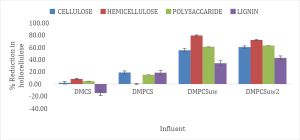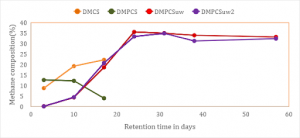Solid state anaerobic co-digestion (SSCoD) has attracted huge attention in the renewable energy industry due to the potential to solve nutrient imbalance challenge. However, SSCoD potential as biogas source is often limited except the process parameters are systematically optimized. Hence, in this study, we investigated the impact of 4%-NaOH-pretreatment and two agitation frequencies (two-day and seven-day periodic agitation), being part of the process parameters, on biogas composition and methane yield.
What Did We Do?
In our study, four solid-state treatments (DMPCSuw, DMPCSuw2, DMPCS, and DMCS) prepared from the co-digestion of dairy manure and corn stover under total solid of 16% were used to examine the effect of pretreatment with or without washing and agitation frequency on biogas production and composition. Treatment DMPCSuw2 represents dairy manure, inoculum, and unwashed pretreated corn stover agitated every two-days; Treatment DMPCSuw represents dairy manure, inoculum, and unwashed pretreated corn stover agitated every seven-days; Treatment DMPCS represents dairy manure, inoculum, and washed pretreated corn stover agitated every seven-days; and Treatment DMCS represents dairy manure and inoculum with untreated corn stover agitated every seven-days. 1000g of these treatments were loaded into four litres working volume PVC digesters installed in a thermostatically-controlled-water bath set at 37oC.The gas composition (methane, carbon dioxide and hydrogen sulphide) and yield from these treatments were monitored and quantified. Other process parameters investigated before and after the digestion process were ADF, NDF, ADL, ORP, pH, volatile fatty acids concentration and composition, alkalinity, and ammonia-nitrogen. Also investigated was the volatile solids.
What Have We Learned?
Considering treatments with either of the two processes (washing and unwashing) after pretreatment, we observed that treatments prepared with unwashed 4% NaOH pretreated corn stover (DMPCSuw and DMPCSuw2) showed significantly higher acetic acid production (p < 0.05), irrespective of agitation frequency (Figure 1). Acetic concentration at the end of the experiments was over 50 g/L (Figure 1). This suggests higher biogas yield and invariably more energy generation.

Furthermore, as shown in Figure 2, there was significantly higher holocellulose degradation in the treatments with unwashed 4% NaOH pretreated corn stover (DMPCSuw and DMPCSuw2) compared with DMCS and DMPCS (P < 0.05). Furthermore, cellulose and holocellulose was over 50% in the DMPCSuw and DMPCSuw2 treatments (Figure 2). These further substantiate the effectiveness of DMPCSuw and DMPCSuw2 treatments in energy generation from the co-digestion of dairy manure and corn stover under solid-state condition.

High sulphide production (> 5000 ppm) in the DMCS and DMPCS treatments on the 10th days might be the reason for the low methane composition (Figure 4). This was because aside from the potential competition of sulphur reducing bacteria with methanogens which obviously affected the anaerobic process in treatments DMCS and DMPCS, the digesters for DMCS and DMPCS treatments equally for failure after the third week.
Consistent methane composition after the third week of our experiment and the low sulphide production from DMPCSuw and DMPCSuw2 treatments (Figures 3 & 4) suggest that, pretreatment without washing could enhance biogas yield and methane composition.
However, there was no significant difference between 2 days and 7 days agitation frequency in our study, a trend which suggests that 7-days agitation frequency will likely minimize agitation energy input for the SSCoD study.


Future Plans
We intend to improve methane production from our unwashed treatments, this will add more economic value to the solid-state anaerobic co-digestion process.
Authors
Shafiqur Rahman, Associate Professor, Agricultural & Biosystems Engineering Department, North Dakota State University
Ademola Ajayi-Banji, Graduate Student, Agricultural & Biosystems Engineering Department, North Dakota State University
Additional Information
Will be available at North Dakota State University library by 2020.
Acknowledgements
North Dakota State University Development Foundational Grant.
The authors are solely responsible for the content of these proceedings. The technical information does not necessarily reflect the official position of the sponsoring agencies or institutions represented by planning committee members, and inclusion and distribution herein does not constitute an endorsement of views expressed by the same. Printed materials included herein are not refereed publications. Citations should appear as follows. EXAMPLE: Authors. 2019. Title of presentation. Waste to Worth. Minneapolis, MN. April 22-26, 2019. URL of this page. Accessed on: today’s date.

